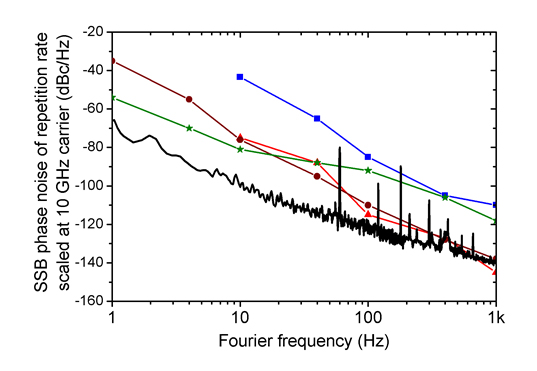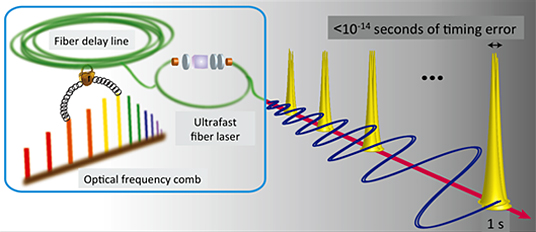KAIST
BREAKTHROUGHS
Research Webzine of the KAIST College of Engineering since 2014
Spring 2025 Vol. 24KAIST developed a novel ultralow noise photonic oscillator with an error of a quadrillionth of a second
KAIST developed a novel ultralow noise photonic oscillator with an error of a quadrillionth of a second
KAIST developed a new class of photonic signal generators with an unprecedented 7 femtoseconds (7×10-15 s) timing error per second, corresponding to an error of less than 1 second over 1 million years.
Article | Fall 2016
Oscillators generate highly periodic clock signals that are used to synchronize the operation of systems. Today, high-performance oscillators play an important role not only in information and communication systems, but also for large-scale scientific facilities (such as particle accelerators and phased-array antennas), test and measurement, defense, time keeping, and navigation systems, to name only a few.
Lower noise oscillators can not only improve the performance of such existing timing systems, but also allow new high-precision applications that were not possible before. Today’s state-of-the-art low-noise oscillators are based on specially designed and manufactured microwave or optical cavities that are both highly complex and expensive, limiting the breadth of their application.
To overcome this limitation, Professor Jungwon Kim’s group at KAIST pursued an alternative approach of generating ultralow-noise periodic signals using an all-fiber photonic technology that is cheaper and features a simpler design. Their result shows a timing error of only 7 femtoseconds (7×10-15 seconds) over a period of 1 second, corresponding to an error of less than 1 second in 1 million years.
For years, Professor Kim’s group has been the world leader in minimizing the noise (timing jitter in particular) in mode-locked fiber lasers and applying such low-noise lasers to high-precision timing systems. His group was the first to show that free-running fiber lasers can achieve sub-100-attosecond (attosecond = 10-18 s) timing jitter, a result that was also featured in the “Research Highlights” of the February 2012 issue of Nature Photonics.
However, due to the lack of a restoring force mechanism, the jitter of free-running lasers undergoes random walk and rapidly diverges over longer time scales. For example, a recent study conducted by Kim’s group showed that the absolute RMS jitter of free-running fiber lasers reaches 20 picoseconds over a period of 1 second despite exhibiting only 710 attoseconds of jitter within 100 microseconds. Therefore, maintaining attosecond-level absolute timing jitter over much longer time scales could significantly increase the performance of many existing applications and open up new applications in precision timing both in optics and electronics. To suppress the timing jitter over longer time scales, free-running mode-locked lasers can be locked to an ultrahigh-quality-factor (Q) radio frequency (rf), microwave, or optical reference. However, these previous state-of-the-art techniques are not only complex or expensive, but also fragile and alignment-sensitive. Therefore, a simpler, more robust stabilization method that can still achieve both ultralow timing jitter and ultrahigh frequency stability is highly desirable.
Professor Kim’s group demonstrates a simple all-fiber-based method for the timing jitter stabilization of mode-locked lasers. This novel method is based on the direct repetition-rate stabilization of a mode-locked laser to a few-kilometer-scale fiber delay line. Using this method to stabilize a mode-locked Er-doped fiber laser enables the all-fiber photonic generation of optical pulse trains with sub-femtosecond absolute timing jitter over a 0.01-second time scale, which is about 100 times longer than free-running lasers. Over a 1-second time scale, the integrated absolute RMS timing jitter is suppressed by a factor of >1000, from 10 picoseconds to only 7 femtoseconds. Currently, the overall stabilization system fits within the boundaries on a sheet of A4 paper, and Kim’s group believes that it can be further scaled down with better engineering in packaging.
Professor Kim expects that this high-performance yet simple photonic oscillator will find various applications ranging from basic science to space systems. Some of the potential application areas include large-scale scientific facilities (such as free-electron lasers and radio astronomy), information systems (such as analog-to-digital converters and clock distribution networks), space technology (such as navigation and time-keeping), defense systems (such as photonic radars and Light Detection And Ranging (LiDAR)), and environmental technology (such as remote sensing and distributed sensors). The group also has a plan to commercialize the technology in the near future with more compact and robust packaging.
Most Popular

When and why do graph neural networks become powerful?
Read more
Smart Warnings: LLM-enabled personalized driver assistance
Read more
Extending the lifespan of next-generation lithium metal batteries with water
Read more
Professor Ki-Uk Kyung’s research team develops soft shape-morphing actuator capable of rapid 3D transformations
Read more
Oxynizer: Non-electric oxygen generator for developing countries
Read more

